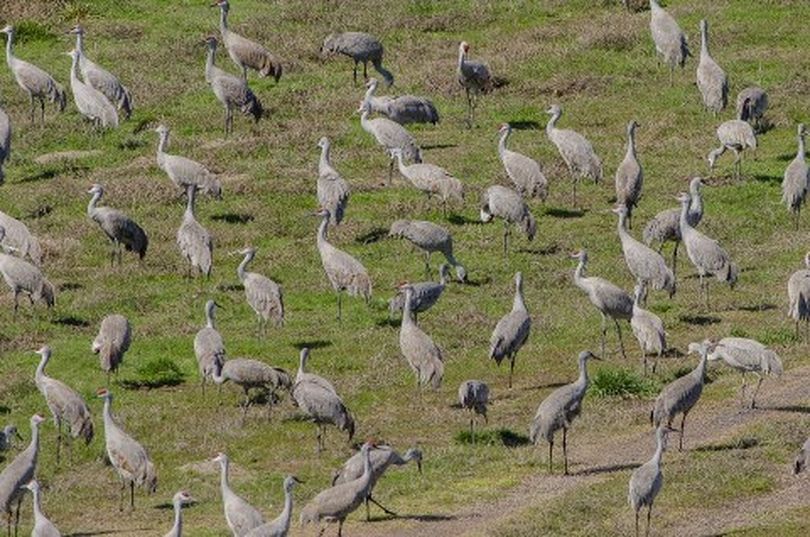Sandhill cranes return to greet 20th annual Othello bird festival

WILDLIFE WATCHING -- Sandhill cranes -- on their spring migration route from Lodi, California to Alaska -- are flocking into the Columbia National Wildlife Refuge and surrounding area as though they welcome the spotlight of the 20th annual Othello Sandhill Crane Festival, which runs Friday through Sunday.
The event features numerous ways to view and learn more about the beautiful birds and other wildlife and even the landscape that greets them, shaped by the Ice Age Floods.
- Register for field trips at othellosandhillcranefestival.org
The Yakima Herald describes viewing the cranes as a unique experience:
Venture too close to the gray-feathered, red-headed, black-billed birds and they begin to stand up, often stretching out their wings and prancing around as they prepare to take flight. Sometimes just a handful will gather in fields of corn or other crops, and other times hundreds bunch together to create a magnificent sight best viewed from a distance through binoculars.
Large numbers of cranes began resting and refueling in the area about a decade after water first arrived for irrigation in 1955 from project facilitated by Grand Coulee Dam. Crop and feed residue provides an excellent source of carbohydrates for the birds on their journey along the Pacific Flyway, a major north-south route stretching all the way from Alaska to Patagonia, at the southern tip of South America.
Groups of birds generally start showing up around mid-February and can be seen for at least six weeks, although they didn’t arrive until closer to the start of March this year with all the cold and snow.
According to the Herald:
Dan Haas, a U.S. Fish and Wildlife biologist in Burbank, said this particular flock of sandhill cranes numbers about 35,000, although not all of them stop near Othello. But enough do that retired U.S. Fish and Wildlife bird expert Randy Hill recognized the opportunity and spearheaded the first festival in 1998, a one-day event that drew 400 people.
As word spread and organizational efforts increased, the festival expanded to two days in 2003, then three in 2007. By 2012, attendance had reached about 1,600 people, and Chris Braunwart, the festival’s co-chair, said it’s stayed steady since then with limited space at hotels and the high school — where lectures are held — allowing little room for growth.
While many of those visitors seek the opportunity to view the cranes, others attend the festival to learn about the region’s remarkable geological features, many of which were formed during the last ice age. Uniqe basalt rock columns shape the landscape of the Columbia Wildlife Refuge and Potholes Reservoir to the north offers a stunning array of miniature lakes.
Experts devoted to the study of wildlife, geology and agriculture will lead 45 lectures, starting with Central Washington professor Nick Zentner’s popular “Central Washington is Disneyland for Geologists” on Friday night and concluding Saturday night with “Cranes are People Too!” from Dr. Gary Ivey of the International Crane Foundation. A special 20th anniversary luncheon on Saturday will reflect back on the history of the festival and pay tribute to Will Coats, a volunteer at every Sandhill Crane Festival who died in January.
“He worked out at the refuge and he would go out and help when they were banding birds, or he’d build the Kessler nests, which are just little boxes for them to nest in,” Braunwart said. “He’s been on the board for a very long time.”
Crane tours go out in the mornings and evenings from late Friday to early Sunday, including a 30-mile bike tour south towards the Scooteney Reservoir, led by Braunwort and Geri Schrom. A few spots remain for geology tours on Sunday, and Braunwart noted an agriculture guide and a U.S. Fish and Wildlife biologist accompany tour groups on every bus.
But other visitors travel to Othello to see the cranes on their own in the weeks preceding and following the festival. Braunwort said many community businesses enjoy the annual surge created by the elegant birds she finds endlessly fascinating